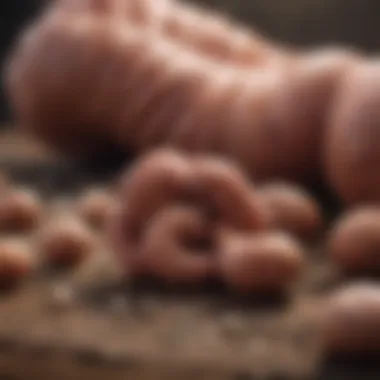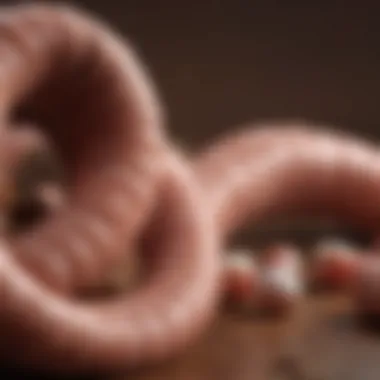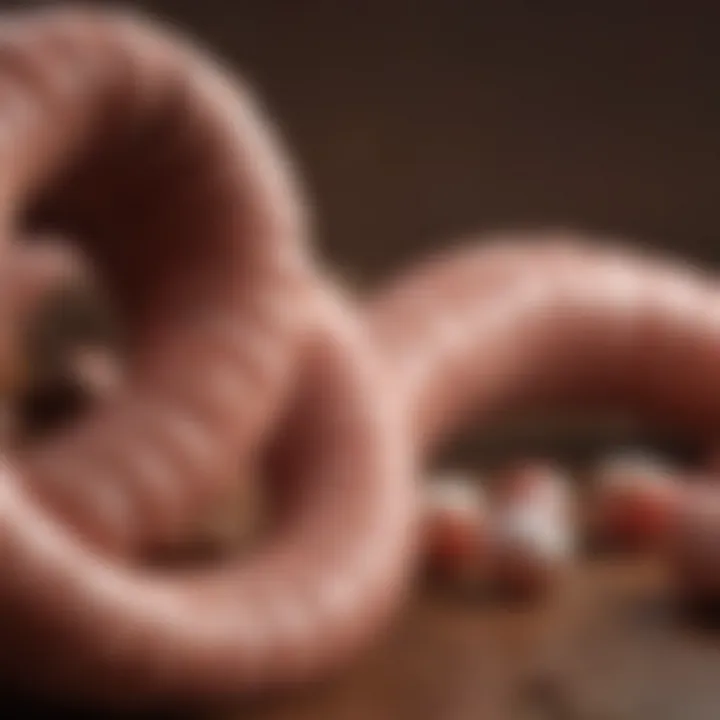Recognizing the Signs and Symptoms of Bowel Obstruction


Intro
Bowel obstruction is a condition that can profoundly affect both humans and pets. Recognizing the signs and symptoms promptly can make a significant difference in management and outcomes. This article delves into the intricacies of bowel obstruction, providing essential information for pet owners and enthusiasts alike. Understanding the implications of this condition is critical for ensuring timely and effective care. We will explore the signs and symptoms associated with bowel obstruction, the potential complications it can cause, and the importance of intervention.
Understanding Your Pet
Breed Traits
Different pet breeds can exhibit varied predispositions to bowel obstructions. For example, small dog breeds, like Dachshunds and Chihuahuas, may have unique anatomical characteristics that could lead to obstruction. Understanding these breed traits is vital for identifying potential risks early on.
Common Temperaments
The behavior of your pet often changes when they are not feeling well. Pets may become lethargic or show signs of discomfort when experiencing bowel problems. Being aware of your pet's normal behavior can help you detect changes indicative of a potential obstruction.
Special Needs
Some pets may have special dietary needs or health conditions that increase their risk for bowel obstruction. For instance, pets with a history of gastrointestinal issues may require closer monitoring and tailored diets. Knowledge regarding your pet's health history informs better preventive measures.
Pet Care Essentials
Nutrition and Feeding Guidelines
Proper nutrition is critical in preventing bowel obstruction. Here are some key guidelines to consider:
- Provide a balanced diet suited to your pet's age, breed, and health status.
- Avoid overfeeding, which can lead to gastrointestinal complications.
- Keep an eye on any changes in appetite, as this could signal underlying issues.
Grooming Tips and Techniques
Regular grooming is not just for aesthetics; it also promotes health. Certain breeds require specific grooming techniques to prevent hair ingestion, which can lead to blockages.
Health and Wellness
Regular veterinary check-ups can help identify risks early. Vaccinations, parasite control, and routine blood work are essential. Owners should pay attention to any sudden changes in behavior or physical condition, as these may be the first indicators of bowel problems.
Training and Behavior
Basic Training Techniques
Proper training can reduce stress on both pet and owner, which can help in identifying health issues earlier. Basic commands can assist in managing your pet and ensuring they do not eat harmful items that could lead to obstruction.
Behavioral Problems and Solutions
Sometimes, pets develop habits of eating non-food items, which can increase the risk for obstruction. Recognizing this behavior is critical, as it can lead to more serious health issues.
Mental Stimulation Activities
Engaging your pet in mental stimulation can prevent boredom-related behaviors that might lead to eating undesirable items. Interactive toys and puzzles can keep their minds sharp and divert attention from harmful chewing.
Engaging with Your Pet
Interactive Games and Toys
Interactive toys can provide mental stimulation and are also helpful in developing healthy play habits. Selecting the right toys can engage your pet while offering a safe outlet for their energy.
Safe Outdoor Activities
Monitoring your pet during outdoor activities is important. Be alert to what they are chewing or picking up from the ground, as this can prevent potential issues down the line.
Family-Friendly Pet Interactions
Ensuring that every family member understands how to interact safely with the pet helps prevent accidental ingestion of harmful objects or food that could cause blockages.
Pet Adoption and Integration
Choosing the Right Pet for Your Lifestyle
When adding a pet to your family, consider their breed and health history. Some breeds are more prone to bowel issues, and understanding these risks can guide your choice.
Preparing Your Home for a New Pet
A safe environment is essential. Remove potential hazards and hazardous items to minimize the risk of bowel obstruction.
Tips for Smooth Prologue
Gradual introductions between pets and family can reduce stress and anxiety, promoting a healthier environment where problems can be detected early.
Important Note: Always consult a veterinarian if you suspect bowel obstruction. Prompt intervention can save lives.


Understanding these key aspects can lead to better care and awareness regarding bowel obstruction in pets. The signs and symptoms may vary, but knowledge of your pet's health can make a difference. By becoming informed and observing your pet closely, you can ensure their well-being and address any health concerns as they arise.
Prolusion to Bowel Obstruction
Bowel obstruction is a critical condition that can significantly impact gastrointestinal function in both humans and animals. It occurs when there is a blockage in the intestines, preventing the normal passage of food, liquids, and gas. The importance of understanding bowel obstruction lies in its potential complexity and the implications it has on health. Recognizing the signs and symptoms early can lead to timely intervention, which is crucial for recovery.
In this section, we will explore why awareness about bowel obstruction is essential. First, it is important to understand how obstructed bowels can lead to severe health issues like dehydration, sepsis, or even intestinal perforation. Without prompt medical attention, these complications can escalate quickly and may result in serious consequences.
One key aspect of bowel obstruction is its various causes. Factors can include previous abdominal surgeries that scar the intestines, certain medical conditions that affect bowel function, and dietary habits that may predispose an individual to this issue. Understanding these factors gives both pet owners and animal enthusiasts insight into preventative measures that can help maintain the health of their pets.
Generally, recognizing the signs early may save lives. Symptoms such as abdominal pain, bloating, nausea, and changes in bowel movements are critical clues. If these symptoms arise, it’s vital to seek veterinary advice or intervention. Prompt action in a medical emergency often protects pets from enduring further complications. It’s about establishing awareness and being attentive.
"Early detection of bowel obstruction can significantly improve outcomes; being proactive is key in management and treatment."
Definition and Classification
Understanding bowel obstruction requires a clear definition and classification of the condition. This knowledge is crucial for proper diagnosis and treatment. Bowel obstructions can significantly affect an individual's health, leading to serious complications if not addressed quickly.
Bowel obstruction can be categorized into two main types: mechanical and functional. Both types have unique characteristics and implications on gastrointestinal function. Recognizing these types not only aids in diagnosis but also guides treatment strategies.
Mechanical Bowel Obstruction
Mechanical bowel obstruction refers to a physical blockage in the intestines. This blockage prevents the contents of the bowel from moving through. There are various causes for this condition, including:
- Adhesions: Scar tissue can form after surgeries and stick parts of the intestine together.
- Hernias: Portions of the intestine can protrude through weak areas in the abdominal wall.
- Tumors: Growings within or outside the intestine can block its passage.
- Volvulus: This occurs when a part of the intestine twists, cutting off blood supply.
- Intussusception: A section of the intestine folds into itself, leading to obstruction.
Each cause may require distinct diagnostic and treatment approaches. Prompt identification and management are key, as untreated mechanical obstruction can result in severe bowel ischemia or perforation.
Functional Bowel Obstruction
Functional bowel obstruction differs from mechanical obstruction in that there is no physical blockage. In this case, the intestines are unable to contract properly or coordinate movement effectively. Several factors can lead to functional obstruction, including:
- Neurological disorders: Conditions like Parkinson’s disease can affect bowel motility.
- Metabolic abnormalities: Electrolyte imbalances may hinder normal bowel function.
- Medications: Some drugs can slow down intestinal movement, leading to functional blockage.
- Infections: Diseases affecting the digestive system can disrupt normal functioning.
Functional bowel obstruction requires thorough evaluation, as the treatment may focus on managing underlying conditions rather than physical intervention. It is essential to understand both types' distinctions for better health outcomes.
"Recognizing the differences between mechanical and functional bowel obstructions can significantly impact treatment choices and patient recovery."
Common Signs and Symptoms
Understanding the common signs and symptoms of bowel obstruction is critical for early diagnosis and treatment. Recognizing these indicators promptly can significantly improve patient outcomes. Each symptom presents distinct characteristics that can help in identifying the underlying issue behind the obstruction. Furthermore, knowing the signs can be beneficial not just for humans but also for animals, as pet owners must pay attention to their pets' behaviors and conditions.
Abdominal Pain
Abdominal pain is often the first sign of a bowel obstruction. Patients may experience cramps, sharp pain, or a dull ache. This discomfort is usually intermittent and can vary in intensity. Pain occurs as the intestine tries to push contents past the blockage. It is essential to note the pain’s duration and location, as this can help healthcare providers understand the obstruction’s nature.
For pets, signs of abdominal pain may include whimpering, hiding, or changes in eating habits. Owners must monitor their pet’s behavior closely and seek veterinary help if they detect significant discomfort.
Bloating and Distension
Bloating generally appears as a swelling of the abdomen. It results from gas accumulation and can be accompanied by visible distension. This symptom often signifies a more severe obstruction. Patients may feel a sense of fullness and experience increased pressure in the abdomen.
In animals, bloating can be particularly dangerous as it may lead to a condition known as gastric torsion. Pet owners should watch for swollen bellies or discomfort when touched and act quickly if they notice these signs.
Nausea and Vomiting
Nausea and vomiting are common responses when the digestive system is malfunctioning. These symptoms may occur several times in a short period. Vomitus may contain undigested food, bile, or, in severe cases, fecal matter, which can indicate a severe obstruction. This condition often leads to discomfort and a reluctance to eat, further worsening the individual’s health.
For animals, nausea can lead to changes in behavior. They might refuse food or show signs of distress when eating. Prompt intervention is crucial in both humans and pets to avoid dehydration and long-term complications.
Constipation or Diarrhea
Constipation or diarrhea can show up with bowel obstruction, depending on the type of obstruction. In many cases, intestinal blockages prevent normal stool passage, leading to constipation. Alternatively, if the obstruction is partial, some liquid stool may pass, resulting in diarrhea.
Understanding the nature of these symptoms can guide owners and healthcare providers to look for the right solutions. For pets, noticing a change in bathroom habits can be a signal for potential obstruction and should not be ignored.
Recognizing these signs early can save lives, providing crucial time for intervention and treatment.
Secondary Symptoms
Understanding secondary symptoms of bowel obstruction is crucial for recognition and prompt action. These symptoms often arise as a result of the primary blockage in the gastrointestinal system. Timely identification of these signs can prevent further complications and improve patient outcomes. Secondary symptoms can indicate the severity of the obstruction and the body’s response to it. Thus, they merit careful attention in both human and veterinary contexts.
Dehydration Signs
Dehydration is a significant concern when dealing with bowel obstruction. As the obstruction prevents normal passage of fluids through the intestines, the body is at risk of losing essential fluids. This loss may present itself in several ways. Signs include excessive thirst, dry mouth, reduced urine output, and fatigue. In pets, symptoms may be more subtle but can include lethargy and a decrease in skin elasticity.
Monitoring for dehydration should not be overlooked. Dehydration can escalate quickly and lead to severe health issues. It is a sign that the body is struggling to maintain its balance and requires immediate attention. If dehydration is suspected, medical intervention is necessary. Rehydration therapy may be employed, which can include intravenous fluids to restore normal fluid balance and electrolyte levels.


Electrolyte Imbalance Effects
Electrolyte imbalances are another critical aspect linked to bowel obstruction. The gastrointestinal tract plays a key role in regulating electrolytes such as sodium, potassium, and chloride. When obstruction occurs, this balance can be disrupted. Common symptoms of an imbalance may include irregular heartbeat, muscle cramps, confusion, and lethargy. In pets, it can lead to serious behavioral changes and a lack of energy.
Maintaining proper electrolyte levels is vital for cellular function and overall well-being. In cases of bowel obstruction, the loss of electrolytes can occur due to vomiting, diarrhea, or inadequate absorption. Monitoring electrolyte levels is therefore essential during diagnosis and treatment.
Severe imbalances can lead to life-threatening conditions. Thus, it is important to promptly address any signs of electrolyte disturbance through medical evaluation and appropriate treatment strategies such as electrolyte repletion.
Recognizing the signs of dehydration and electrolyte imbalance can be lifesaving. Early intervention can prevent serious complications associated with bowel obstructions.
Risk Factors and Causes
Understanding the risk factors and causes of bowel obstruction is crucial for both prevention and timely intervention. Recognizing who may be more susceptible to this condition allows for better management of health, especially for pet owners concerned about their animals or individuals who themselves may be at risk. Identifying specific risk factors can lead to early diagnosis and treatment, which can prevent serious complications. It is vital to assess the background of the individual or animal in question, considering past medical history, current health conditions, and lifestyle habits.
Previous Abdominal Surgery
A history of previous abdominal surgery is one of the most significant risk factors for developing bowel obstruction. Surgical procedures can lead to the formation of scar tissue, or adhesions, which can obstruct the normal passage of intestinal contents. This scar tissue may bind the intestines together or create constrictions that hinder movement. Surgical techniques and types of operations play a role in determining the degree of risk. For instance, complex surgeries on the intestines can increase the likelihood of developing adhesions. Keeping track of any surgeries and potential complications is important for ongoing health monitoring.
Certain Medical Conditions
Several medical conditions can elevate the risk of bowel obstruction. Conditions such as Crohn's disease and cancer can lead to inflammation or tumor growth, impairing the intestinal tract's normal function. Additionally, conditions affecting motility, such as diabetes or neurological disorders, may also contribute to the risk. It is crucial to manage these conditions attentive to how they may affect bowel health. Regular check-ups and monitoring of existing conditions can help in preventing escalation into an obstruction.
Dietary Factors
Dietary factors can also play a role in bowel health. Diets low in fiber and hydration can lead to constipation, increasing the risk of blockage. Certain foods may cause specific reactions or intolerances, leading to inflammation. For example, excessive consumption of processed foods or those high in fat might contribute to slower bowel movements. To mitigate this risk, adopting a balanced diet that includes adequate fiber, fruits, and vegetables is essential. Monitoring dietary habits and their effects on the body can assist in preventing bowel issues.
Keeping a food diary may help identify foods affecting bowel health and allow for adjustments before issues arise.
Diagnosis of Bowel Obstruction
Diagnosis plays a crucial role in managing bowel obstruction. A precise diagnosis informs potential treatment options and overall prognosis. If left unchecked, bowel obstruction can lead to significant complications. Timely diagnosis can help avoid unnecessary surgeries and inappropriate treatments. Health professionals typically follow a multi-step approach which often begins with a detailed patient history and physical examination.
Physical Examination
A physical examination serves as the first line of assessment for bowel obstructions. Physicians look for specific signs such as abdominal tenderness, masses, or distension during this process. They may also listen for bowel sounds, which can indicate whether bowel activity is present or absent.
During the examination, the practitioner might ask questions about recent health changes, dietary habits, and any prior surgeries. The reliability of this assessment can depend greatly on clinical experience. Though it offers limited information by itself, it lays the groundwork for further diagnostic testing.
Imaging Techniques
Advanced imaging techniques are important in confirming bowel obstruction. They offer visual confirmation that can guide treatment. Each imaging type has its own strengths and weaknesses. Let's look at three significant imaging options used in this context.
X-rays
X-rays are often the first imaging tool used. They are fast and widely available. This approach can reveal the presence of gas and fluid levels in the intestines, which signal obstruction. A key characteristic of X-rays is their ability to provide immediate results. This makes them a popular choice in urgent situations.
However, X-rays do have limitations. They may not show subtle abnormalities. For this reason, they are usually followed up with more detailed imaging techniques. So while they offer rapid insights, they don't always provide a complete picture.
CT Scans
CT Scans, or computed tomography scans, provide a more detailed view than plain X-rays. They are valuable for identifying the exact site and cause of the obstruction. A key feature of CT scans is their ability to create cross-sectional images. This helps in pinpointing specific problems like tumors or hernias.
Despite their advantages, CT scans involve exposure to higher doses of radiation. Additionally, the process may take longer than an X-ray. Thus, physicians weigh these factors when recommending CT scans to patients with suspected bowel obstruction.
Ultrasound
Ultrasound imaging is another important diagnostic tool. It uses sound waves to create images of internal organs. A significant advantage of ultrasound is that it does not involve radiation. That makes it safer, especially for children and pregnant women. Ultrasound can highlight fluid collections and bowel wall abnormalities.
However, ultrasound can be operator-dependent, which might affect the reliability of the results. Also, it may not penetrate deeply enough to visualize all types of obstructions. Given its benefits and limitations, ultrasound remains a useful adjunct to other imaging methods.
Laboratory Tests
Laboratory tests supplement the diagnostic process further. Blood tests are conducted to check for signs of infection, dehydration, or electrolyte imbalance. Elevated white blood cell counts may indicate the presence of an infection, while electrolyte levels help in assessing the severity of the obstruction. Together with imaging techniques, laboratory tests can create a more comprehensive understanding of the patient's condition.
Complications Associated with Bowel Obstruction
Understanding the complications associated with bowel obstruction is crucial. These complications can arise from untreated or improperly managed cases. Delayed intervention can cause severe outcomes for both humans and animals. Awareness of these complications allows for timely medical responses that may prevent further health deterioration.
Ischemia of the Intestines
Ischemia refers to a reduction in blood flow to the intestines. This condition can occur if the blood supply is compromised due to bowel obstruction. When blood flow is limited, the tissue can begin to die, leading to significant abdominal pain and potential organ damage. If this ischemia is not resolved, it can progress to necrosis, which is the death of the affected tissue.
Symptoms of ishemia may include:
- Severe abdominal pain
- Tenderness when touching the abdomen
- Changes in bowel habits
Prompt diagnosis and intervention are essential to restore blood flow and limit injury.


Perforation Risks
Perforation is a serious complication of bowel obstruction. It occurs when a section of the bowel develops a hole. This can happen due to increased pressure from trapped contents, causing the intestinal wall to rupture. Once perforation occurs, the contents of the intestine can spill into the abdominal cavity, leading to severe infections.
Symptoms of perforation include:
- Sudden, intense abdominal pain
- Fever
- Worsening nausea and vomiting
Perforation requires immediate surgical repair to prevent life-threatening consequences.
Sepsis Development
Sepsis is a potentially life-threatening condition caused by the body's response to infection. In the context of bowel obstruction, if bacteria escape from the intestinal tract due to perforation or ischemia, this can lead to sepsis. The body's immune system can begin to overreact, leading to widespread inflammation and damage.
Signs of sepsis may include:
- Elevated heart rate
- Rapid breathing
- Confusion or disorientation
Timely recognition of sepsis and aggressive medical treatment are vital. Understanding these complications not only helps in recognizing symptoms but also highlights the importance of seeking medical attention promptly.
Early intervention can be the key to preventing dire outcomes associated with bowel obstructions.
Recognizing these complications inspires proactive health management for pets and their owners. Knowledge about bowel obstruction will ultimately support better decision-making regarding veterinary care.
Management and Treatment Options
The management of bowel obstruction is paramount due to its potential complications and the severity of symptoms presented. This section addresses essential strategies for treatment, highlighting approaches that vary depending on the severity and cause of the obstruction. Understanding these options helps in early detection and effective intervention, which is crucial for recovery and the quality of life for both humans and pets.
Initial Conservative Measures
Before resorting to invasive techniques, healthcare providers often implement initial conservative measures. These methods include:
- NPO Status: Keeping the patient NPO (nothing by mouth) can prevent further complications. This allows the bowel to rest and may help reduce swelling.
- Fluid Replacement: Administering intravenous fluids is critical. It helps in maintaining hydration and correcting electrolyte imbalances, thereby supporting overall health during the obstruction.
- Nasogastric Tube: In some cases, a nasogastric tube may be utilized to decompress the stomach. This procedure helps relieve pressure by removing excess gas and liquid, facilitating a more comfortable recovery.
The aim of conservate measures is to monitor the condition closely and to determine if the obstruction resolves on its own. It is vital to assess the response to these treatments regularly.
Surgical Interventions
When conservative treatments fail, surgical intervention may be necessary. The urgency of surgery often depends on the patient's condition. Possible surgical options include:
- Laparotomy: A standard procedure for diagnosing and treating obstructions. It involves a larger incision in the abdominal wall to access the intestines directly.
- Laparoscopy: This is a minimally invasive method. Surgeons use small incisions and a camera to navigate the abdominal cavity. It usually results in less post-operative pain and a quicker recovery time.
- Resection: If a segment of the intestine is severely damaged or necrotic, a section may need to be surgically removed. This intervention is often followed by reconnection of the remaining intestine, a procedure known as anastomosis.
It is crucial to choose the right surgical method, as each option has benefits and risks. Discussing these with a vet or doctor can provide clarity on the path to recovery.
Post-Surgery Care
Post-operative care is just as important as the actual surgery. Careful monitoring and proper management can prevent complications and support healing. Key components of post-surgery care include:
- Monitoring Vital Signs: Keeping an eye on temperature, heart rate, and other vital metrics can help catch any early signs of complications.
- Dietary Adjustments: Gradually reintroducing food, starting with clear liquids and progressing to a regular diet as tolerated can ease the recovery process.
- Pain Management: Providing appropriate pain relief after surgery is vital. This often includes both medications and non-pharmacological strategies, such as alternative therapies.
- Follow-up Appointments: Regular check-ups allow for ongoing assessment of the surgical site and overall recovery, which is essential to ensure that there are no unforeseen complications.
Effective management of bowel obstruction hinges on an understanding of both potential treatments and their implications. Seek veterinary advice whenever symptoms are observed in pets, as prompt care is crucial.
In summary, whether through conservative strategies or surgical interventions, the management and treatment of bowel obstruction require attentiveness, thoroughness, and collaboration between health providers and pet owners to ensure a positive outcome.
Preventive Measures
Preventive measures play a crucial role in managing bowel obstruction. By understanding and implementing these strategies, pet owners and animal enthusiasts can significantly reduce the risk of developing this condition in pets. The importance of prevention lies in its ability to avert the complications associated with bowel obstructions, ensuring the well-being and longevity of pets.
Dietary Recommendations
A well-balanced diet is essential for maintaining healthy gastrointestinal function. Dietary recommendations include:
- High Fiber Foods: Including fiber-rich foods like fruits and vegetables can promote healthy bowel movements. Fiber helps in maintaining the regularity of the digestive system, reducing the risk of constipation-related obstructions.
- Moisture-rich Diet: Offering foods with high moisture content can aid in keeping the digestive tract hydrated. This is especially important for pets who may not drink adequate amounts of water.
- Controlled Portions: Feeding pets smaller, more frequent meals can prevent overeating. Overeating can lead to bloating and increase the likelihood of an obstruction.
- Avoid Chewy or Small Objects: Pets, particularly dogs, may ingest foreign objects. Monitoring what they chew on and ensuring they do not have access to small items can reduce the risk of mechanical obstructions.
To implement these recommendations, consider consulting with a veterinarian who can tailor dietary suggestions specific to your pet’s needs.
Regular Medical Check-ups
Routine veterinary check-ups are essential for early detection of potential health issues, including those that may lead to bowel obstruction. Regular medical assessments provide several benefits:
- Monitoring Digestive Health: Regular examinations help in assessing the overall health of a pet's digestive system. This allows for the identification of early signs of gastrointestinal distress.
- Vaccinations and Treatments: Keeping vaccinations up to date can protect against diseases that might indirectly affect bowel health. Preventative medications against parasites are equally important, as infestations can lead to obstructions.
- Behavior Observations: Routine visits give veterinarians the chance to observe behavioral changes or symptoms that pet owners might miss. Addressing these observations promptly can be critical.
Ensuring regular visits to the veterinarian is a significant part of maintaining a pet’s health. It allows pet owners to gain knowledge about their pet's specific risks regarding bowel obstructions.
Effective preventive measures can greatly decrease the likelihood of bowel obstructions in pets, ensuring their health and vitality are prioritized.
Finale
In this article, we have delved into the complexities of bowel obstruction. Understanding the signs and symptoms associated with this condition is crucial for timely diagnosis and treatment. Early recognition of symptoms like abdominal pain, bloating, and nausea can significantly influence outcomes.
Bowel obstruction, if left untreated, can lead to serious complications such as ischemia, perforation, and even sepsis. Therefore, pet owners and enthusiasts must remain vigilant and aware of these warning signs. This knowledge is pivotal in ensuring the well-being of not only their pets but also themselves.
Moreover, adopting preventive measures such as dietary recommendations and regular medical check-ups can mitigate the risks associated with bowel obstruction. These proactive steps empower owners to take control of their pet's health, promoting a better quality of life.
Awareness and knowledge are key to effective intervention in bowel obstruction, safeguarding the health of your beloved pets.



